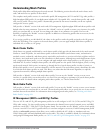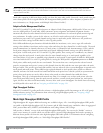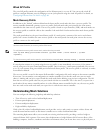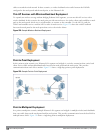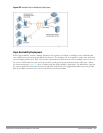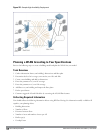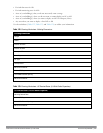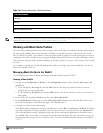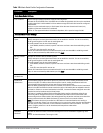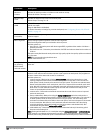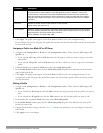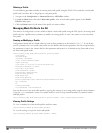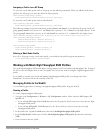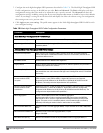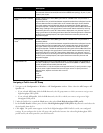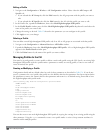
Parameter Description
Basic Mesh Radio Settings
Link Threshold Use this setting to optimize operation of the link metric algorithm.
Indicates the minimal RSSI value. If the RSSI value is below this threshold, the link may be considered
a sub-threshold link. A sub-threshold link is one whose average RSSI value falls below the configured
link threshold.
If this occurs, the mesh node may try to find a better link on the same channel and cluster (only
neighbors on the same channel are considered).
Default: 12. The supported threshold is hardware dependent, with a practical range of 10–90.
Advanced Mesh Radio Settings
802.11a Transmit
Rates
Indicates the transmit rates for the 802.11a radio.
The AP attempts to use the highest transmission rate to establish a mesh link. If a rate is unavailable,
the AP goes through the list and uses the next highest rate.
To modify transmit rates, do one of the following:
l In the WebUI, deselect (uncheck) a specific rate box to use fewer rates when establishing a mesh
link.
l In the CLI, enter the specific rates to use.
Default: All transmission rates are selected and used. If you do not select 802.11a or 802.11g transmit
rates, all rates are selected by default when you click Apply.
802.11g Transmit
Rates
Indicates the transmit rates for the 802.11g radio.
The AP attempts to use the highest transmission rate to establish a mesh link. If a rate is unavailable,
the AP goes through the list and uses the next highest rate.
To modify transmit rates, do one of the following:
l In the WebUI, deselect (uncheck) a specific rate box to use fewer rates when establishing a mesh
link.
l In the CLI, enter the specific rates to use.
Default: All transmission rates are selected and used. If you do not select 802.11a or 802.11g transmit
rates, all rates are selected by default when you click Apply.
Allowed VLANs
on Mesh Link
List the VLAN ID numbers of VLANs allowed on the mesh link.
BC/MC Rate
Optimization
Broadcast/Multicast Rate Optimization dynamically selects the rate for sending broadcast/multicast
frames on any BSS. This feature determines the optimal rate for sending broadcast and multicast
frames based on the lowest of the unicast rates across all associated clients.
When the Multicast Rate Optimization feature is enabled, the controller scans the list of all associated
stations in that BSS and finds the lowest transmission rate as indicated by the rate adaptation state for
each station. If there are no associated stations in the BSS, it selects the lowest configured rate as the
transmission rate for broadcast and multicast frames.
This feature is enabled by default. Multicast Rate Optimization applies to broadcast and multicast
frames only. 802.11 management frames are not affected by this feature and are transmitted at the
lowest configured rate. When enabled, this setting dynamically adjusts the multicast rate to that of the
slowest connected mesh child. Multicast frames are not sent if there are no mesh children.
NOTE: This feature should only be enabled on a BSS where all associated stations are sending or
receiving unicast data. If there is no unicast data to or from a particular station, then the rate adaptation
state may not accurately reflect the current sustainable transmission rate for that station. This could
result in a higher packet error rate for broadcast/multicast packets at that station.
Default: Enabled.
Heartbeat
threshold
Indicates the maximum number of heartbeat messages that can be lost between neighboring mesh
nodes.
Default: 10 missed heartbeats. The range is 1–255.
Table 135:
Mesh Radio Profile Configuration Parameters
DellPowerConnectW-SeriesArubaOS6.2 | User Guide SecureEnterpriseMesh | 451



